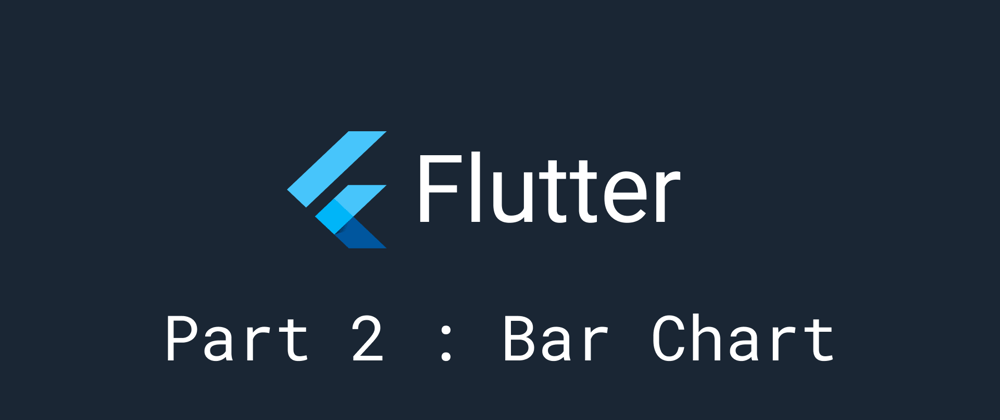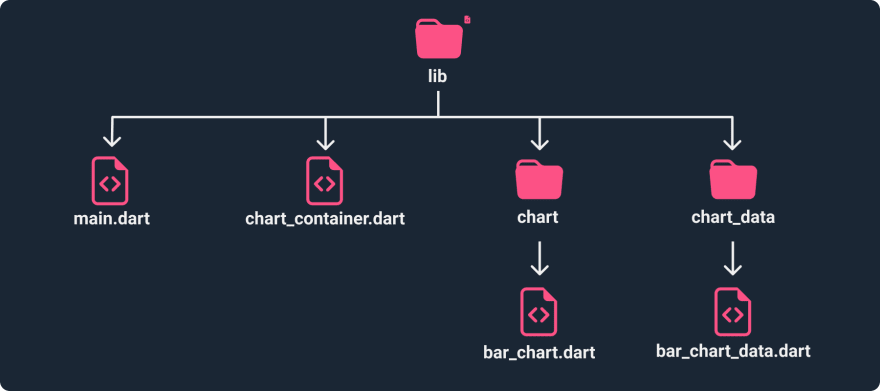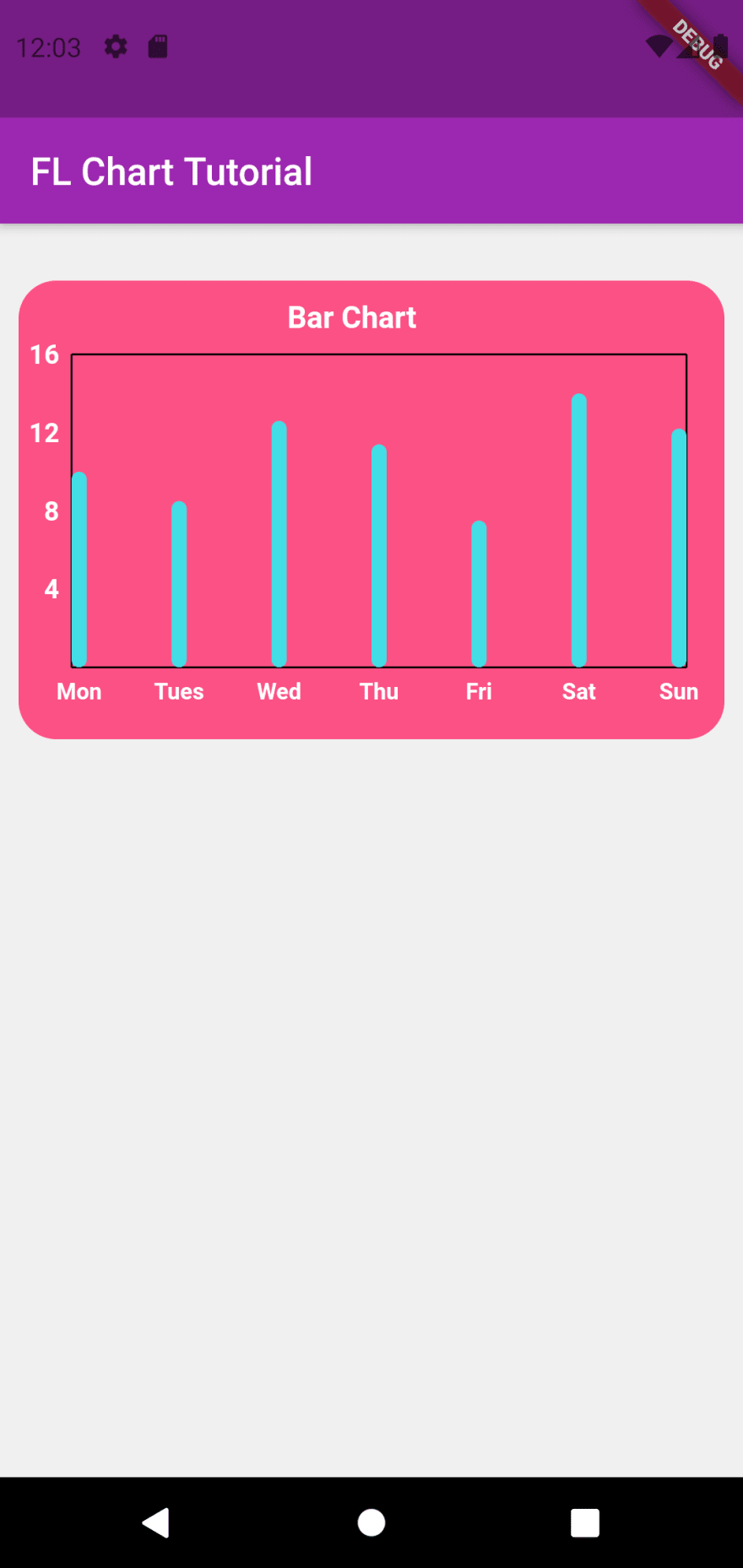A. Introduction
Bar Chart is a type of chart which has a function to show the different values of several aspects of data. Because this type of chart is very readable for the user, many developers implement this chart in web and mobile applications.
So in this tutorial, I will show you how to a create simple bar chart using FL Chart Package.
B. Step To Create Line Chart
The process of creating a bar chart is quite similar to creating a line chart in the previous tutorial.
For that reason, you can skip steps 1 - 4 If you already follow the previous tutorial.
1). Create a Flutter project on your text editor like VS Code or Android Studio. For the detail of creating a new flutter project, you can visit this link : How To Create new Flutter Project
2). Install FL Chart using the below command :
flutter pub add fl_chart
3). In lib folder, create new file named chart_container.dart and insert the below code.
import 'package:flutter/cupertino.dart';
import 'package:flutter/material.dart';
class ChartContainer extends StatelessWidget {
final Color color;
final String title;
final Widget chart;
const ChartContainer({
Key? key,
required this.title,
required this.color,
required this.chart,
}) : super(key: key);
@override
Widget build(BuildContext context) {
return Center(
child: Container(
width: MediaQuery.of(context).size.width * 0.95,
height: MediaQuery.of(context).size.width * 0.95 * 0.65,
padding: EdgeInsets.fromLTRB(0, 10, 20, 10),
decoration: BoxDecoration(
color: color,
borderRadius: BorderRadius.circular(20),
),
child: Column(
mainAxisAlignment: MainAxisAlignment.center,
children: <Widget>[
Text(
title,
style: TextStyle(
color: Colors.white,
fontSize: 16,
fontWeight: FontWeight.bold),
),
Expanded(
child: Container(
padding: EdgeInsets.only(top: 10),
child: chart,
))
],
),
),
);
}
}
Explanation :
-
ChartContainerclass was created to store a chart and avoid writing the same code repeatedly.
class ChartContainer extends StatelessWidget
4). Make 2 new folder named chart and chart_data inside lib folder.
5). Open main.dart in lib folder, then write the below code.
import 'package:fl_chart_tutorial/chart/bar_chart.dart';
import 'package:fl_chart_tutorial/chart_container.dart';
import 'package:flutter/material.dart';
void main() {
runApp(MyApp());
}
class MyApp extends StatelessWidget {
@override
Widget build(BuildContext context) {
return MaterialApp(
title: 'FL Chart Tutorial',
theme: ThemeData(
primarySwatch: Colors.purple,
),
home: MyHomePage(title: 'FL Chart Tutorial'),
);
}
}
class MyHomePage extends StatefulWidget {
MyHomePage({Key? key, required this.title}) : super(key: key);
final String title;
@override
_MyHomePageState createState() => _MyHomePageState();
}
class _MyHomePageState extends State<MyHomePage> {
@override
Widget build(BuildContext context) {
return Scaffold(
appBar: AppBar(
title: Text(widget.title),
),
body: Container(
color: Color(0xfff0f0f0),
child: ListView(
padding: EdgeInsets.fromLTRB(0, 30, 0, 30),
children: <Widget>[
ChartContainer(
title: 'Bar Chart',
color: Color(0xfffc5185),
chart: BarChartContent()
),
],
),
));
}
}
6). Create file inside chart folder named bar_chart.dart. Then create a stateless widget class named BarChartContent.
import 'package:fl_chart/fl_chart.dart';
import 'package:flutter/material.dart';
import 'package:flutter/widgets.dart';
class BarChartContent extends StatelessWidget {
@override
Widget build(BuildContext context) {
return BarChart(
BarChartData(),
);
}
}
7). Input maximum value of axis Y (ex: maxY: 16) in BarChartData widget. The code will like this.
Widget build(BuildContext context) {
return BarChart(
BarChartData(
maxY: 16,
),
);
}
Explanation :
-
maxY: 16is used to give maximum value of y axis.
8). So, we already make basic framework of Bar Chart. After that, we create file called 'bar_chart_data.dart' inside chart_data folder.
bar_chart_data.dart
import 'dart:ui';
import 'package:fl_chart/fl_chart.dart';
List<BarChartGroupData> barChartGroupData = [
BarChartGroupData(x: 1, barRods: [
BarChartRodData(y: 10, colors: [Color(0xff43dde6), Color(0xff43dde6)]),
]),
BarChartGroupData(x: 2, barRods: [
BarChartRodData(y: 8.5, colors: [Color(0xff43dde6), Color(0xff43dde6)]),
]),
BarChartGroupData(x: 3, barRods: [
BarChartRodData(y: 12.6, colors: [Color(0xff43dde6), Color(0xff43dde6)]),
]),
BarChartGroupData(x: 4, barRods: [
BarChartRodData(y: 11.4, colors: [Color(0xff43dde6), Color(0xff43dde6)]),
]),
BarChartGroupData(x: 5, barRods: [
BarChartRodData(y: 7.5, colors: [Color(0xff43dde6), Color(0xff43dde6)]),
]),
BarChartGroupData(x: 6, barRods: [
BarChartRodData(y: 14, colors: [Color(0xff43dde6), Color(0xff43dde6)]),
]),
BarChartGroupData(x: 7, barRods: [
BarChartRodData(y: 12.2, colors: [Color(0xff43dde6), Color(0xff43dde6)]),
]),
];
Explanation :
- In this file, we create a list called
barChartGroupDatawhich has a purpose to show the bar lines. This list will be added tobar_chart.dartfile.
List<BarChartGroupData> barChartGroupData
x: 1is the position of the line bar in the x-axis. For example, we placed the line bar in position 1 on the x-axis.The usage of
barRodsproperty inBarChartGroupDatais to set height and color of line bars.y: 10is the height of the a line bar andcolors: [Color(0xff43dde6), Color(0xff43dde6)]is the background color of a line bar.
BarChartGroupData(x: 1, barRods: [
BarChartRodData(y: 10, colors: [Color(0xff43dde6), Color(0xff43dde6)]),
])
9). Well, we have been creating the bar line data of the bar chart. Next we add 'barChartGroupData' list in 'bar_chart.dart' file.
Add this code in top of the line to import bar_chart_data.dart file .
import 'package:fl_chart_tutorial/chart_data/bar_chart_data.dart';
Most important, add barChartGroupData list to BarChartData widget.
barGroups: barChartGroupData
The code will look like this :
bar_chart.dart
import 'package:fl_chart/fl_chart.dart';
import 'package:fl_chart_tutorial/chart_data/bar_chart_data.dart';
import 'package:flutter/material.dart';
import 'package:flutter/widgets.dart';
class BarChartContent extends StatelessWidget {
@override
Widget build(BuildContext context) {
return BarChart(BarChartData(
maxY: 16,
barGroups: barChartGroupData,
));
}
}
Output
10). When we look at the picture above, we see the bottom and left titles are still untouchable. In this step, we customize left and bottom titles using FlTitlesData widget.
The step to customizing titles in a bar chart is similar to a line chart, so you will use the same code from the previous tutorial.
Open bar_chart.dart file and add this code inside BarChartData widget.
titlesData: FlTitlesData(
bottomTitles: SideTitles(
showTitles: true,
getTextStyles: (value) => TextStyle(
color: Colors.white,
fontSize: 12,
fontWeight: FontWeight.bold
),
getTitles: (value) {
switch (value.toInt()) {
case 1:
return 'Mon';
case 2:
return 'Tues';
case 3:
return 'Wed';
case 4:
return 'Thu';
case 5:
return 'Fri';
case 6:
return 'Sat';
case 7:
return 'Sun';
}
return '';
},
),
leftTitles: SideTitles(
interval: 4,
showTitles: true,
getTextStyles: (value) => TextStyle(
color: Colors.white,
fontSize: 14,
fontWeight: FontWeight.bold
),
getTitles: (value) {
if(value.toInt() == 0) return '';
else return value.toInt().toString();
},
),
),
Explanation :
FlTitlesDatais a widget which has a function to customize titles around charts. On code above, we only customize left and top tiles.When we look at the last output picture, it seems to have too many titles. To decrease titles amount, we set interval to 4 and when we do that, it change the title for example {0,1,2,3,4,5,6,7,8,9,10} to {0,4,8}.
interval: 4
- On bottom titles, we change the format from number to day. We must create a custom function to do that and insert that function to
getTitlesproperty inSideTitleswidget.
getTitles: (value) {
switch (value.toInt()) {
case 1:
return 'Mon';
case 2:
return 'Tues';
case 3:
return 'Wed';
case 4:
return 'Thu';
case 5:
return 'Fri';
case 6:
return 'Sat';
case 7:
return 'Sun';
}
return '';
},
Output
11). Last, we need to change border style and set bar lines alignment to space-evenly.
borderData: FlBorderData(
border: Border.all(
color: Colors.white,
width: 0.5
)
),
alignment: BarChartAlignment.spaceEvenly,
The final code of bar_chart.dart will look like this :
import 'package:fl_chart/fl_chart.dart';
import 'package:fl_chart_tutorial/chart_data/bar_chart_data.dart';
import 'package:flutter/material.dart';
import 'package:flutter/widgets.dart';
class BarChartContent extends StatelessWidget {
@override
Widget build(BuildContext context) {
return BarChart(BarChartData(
titlesData: FlTitlesData(
bottomTitles: SideTitles(
showTitles: true,
getTextStyles: (value) => TextStyle(
color: Colors.white,
fontSize: 12,
fontWeight: FontWeight.bold
),
getTitles: (value) {
switch (value.toInt()) {
case 1:
return 'Mon';
case 2:
return 'Tues';
case 3:
return 'Wed';
case 4:
return 'Thu';
case 5:
return 'Fri';
case 6:
return 'Sat';
case 7:
return 'Sun';
}
return '';
},
),
leftTitles: SideTitles(
interval: 4,
showTitles: true,
getTextStyles: (value) => TextStyle(
color: Colors.white,
fontSize: 14,
fontWeight: FontWeight.bold
),
getTitles: (value) {
if(value.toInt() == 0) return '';
else return value.toInt().toString();
},
),
),
borderData:
FlBorderData(
border: Border.all(
color: Colors.white,
width: 0.5
)
),
alignment: BarChartAlignment.spaceEvenly,
maxY: 16,
barGroups: barChartGroupData,
));
}
}
C. Conclusion
I hope this guide will help you to create a bar chart in flutter. Thank You for reading my article.
Next chapter, i will write a tutorial about creating Pie Chart.
For more detail about this tutorial you can check my Github repo at this link: Source Code of Fl Chart Tutorial
Also, if you want to learn more about FL Chart Packages you can visit the documentation link : Fl Chart Documentation













Top comments (0)